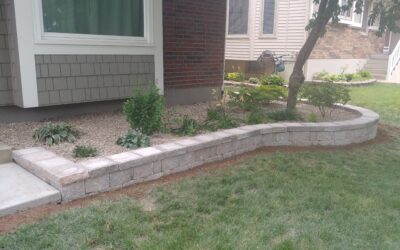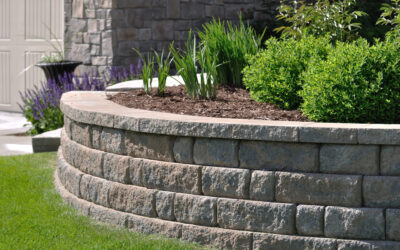Do retaining walls need drainage? Absolutely. Without it, you’re setting yourself up for soil erosion and hydrostatic pressure build-up, which can lead to a total wall failure. Trust me, that’s not something you want to deal with.
But here’s the thing – a lot of folks don’t realize just how crucial proper drainage is for retaining walls. They think they can just slap up a wall and call it a day. But without the right drainage solutions in place, that wall is a ticking time bomb.
Curious about what keeps a retaining wall from crumbling over time? In this article, you’ll find out why good drainage is crucial, learn about effective ways to manage water flow, and discover tips for constructing a durable wall that won’t let you down. Let’s jump in.
Do Retaining Walls Need Drainage?
Ever asked yourself, “Do retaining walls need drainage?” The answer is definitely yes. Proper drainage keeps your retaining wall strong and prevents expensive repairs later. Without good drainage, water can build up behind the wall and cause problems that might make the whole thing collapse.
Why Proper Drainage is Essential for Retaining Walls
Retaining walls are designed to hold back soil and resist the lateral pressure created by the weight of the earth behind them. When water is added to the mix, it significantly increases this pressure, putting extra strain on the wall. Without a way to drain this water, it can saturate the soil, causing it to expand and exert even more force on the retaining wall.
This is where proper drainage comes in. By incorporating drainage systems like weep holes, perforated pipes, and gravel backfill, you give water a way to escape from behind the wall. This helps to relieve hydrostatic pressure and prevent the soil from becoming oversaturated, which can lead to erosion and wall failure.
Common Drainage Issues with Retaining Walls
If the pipes become blocked with sediment or debris, water can’t flow freely through them, leading to a buildup of pressure behind the wall. Similarly, if the pipes are too small or spaced too far apart, they may not be able to handle the volume of water that needs to be drained.
Another issue is failing to install a proper backfill material behind the wall. Using soil that’s too fine or not compacted properly can allow water to seep through and saturate the area behind the wall, increasing the risk of failure. That’s why it’s essential to use a free-draining material like gravel or crushed stone and to compact it in layers to ensure stability.
Signs Your Retaining Wall Needs Better Drainage
So, how can you tell if your retaining wall is suffering from poor drainage? There are a few warning signs to look out for:
- Water stains or efflorescence on the face of the wall
- Bulging or leaning sections of the wall
- Cracks in the wall or the surrounding soil
- Soil erosion or sinkholes behind the wall
- Standing water or soggy soil near the base of the wall
If you spot any warning signs, it’s important to tackle the drainage issues quickly to avoid more damage. Sometimes you can add extra drainage solutions to an existing wall, but if things are really bad, rebuilding the wall with proper drainage might be necessary.
Consequences of Poor Retaining Wall Drainage
If you overlook proper drainage when designing a retaining wall, you’re setting yourself up for serious trouble down the line.
Soil Erosion and Instability
When there’s not enough drainage, soil erosion can become a big problem behind your retaining wall. Water builds up and soaks into the ground, washing away small particles of soil. This creates gaps that weaken the backfill’s stability. Over time, this uneven settling puts extra pressure on the wall and increases its chance of failing.
Hydrostatic Pressure Buildup
Another major consequence of poor drainage is the buildup of hydrostatic pressure behind the retaining wall. When water accumulates and has nowhere to go, it exerts a tremendous amount of force on the wall, pushing against it from behind. Over time, this constant pressure can cause the wall to bow, lean, or even collapse entirely.
I’ve seen this happen on several occasions, particularly with older retaining walls that were built before the importance of drainage was fully understood. In one case, a client called me in a panic because their retaining wall had suddenly buckled and was leaning dangerously towards their house. Upon investigation, we found that the drainage pipes had become clogged, allowing water to build up behind the wall and push it to the breaking point.
Compromised Structural Integrity
Bad drainage can mess with the strength of materials used in a retaining wall. Constant exposure to moisture makes concrete, masonry, and wood deteriorate over time. This leads to cracks, spalling, or even complete collapse.
Costly Repairs and Rebuilding
Perhaps the most significant consequence of poor retaining wall drainage is the cost of repairs and rebuilding. When a wall fails due to inadequate drainage, it often requires extensive excavation, demolition, and reconstruction to fix the problem. This can be a time-consuming and expensive process, especially if the damage has spread to surrounding structures or landscaping.
I’ve seen homeowners spend tens of thousands of dollars to repair or replace retaining walls that failed due to poor drainage. In many cases, these costs could have been avoided entirely by incorporating proper drainage solutions from the start. That’s why I always stress the importance of investing in effective drainage upfront to save money and headaches down the line.
Effective Drainage Solutions for Retaining Walls
Want to keep your retaining wall free from water damage? Making sure it has proper drainage is crucial. I often suggest different methods based on what each project needs, so here are some effective solutions you might consider.
Installing Weep Holes
One of the simplest and most effective ways to promote drainage in a retaining wall is to install weep holes. These are small openings, typically spaced every few feet along the base of the wall, that allow water to escape from behind the wall and relieve hydrostatic pressure.
Weep holes can be created by leaving gaps in the mortar joints of masonry walls or by installing small plastic or metal pipes through the wall. It’s important to cover the holes with a layer of gravel or crushed stone to prevent soil from clogging them over time.
Using Crushed Stone or Gravel Backfill
Another key element of proper retaining wall drainage is using the right backfill material behind the wall. Instead of using soil, which can retain moisture and become saturated, I recommend using a free-draining material like crushed stone or gravel.
This kind of backfill lets water pass easily through the gaps between particles, heading straight into the drainage system instead of building up behind the wall. It’s crucial to use clean, angular stones that fit well together and give solid support to the structure.
Incorporating Geotextile Fabric
I recommend placing a layer of geotextile fabric between the soil and backfill to prevent them from mingling. This breathable fabric allows water to flow through but stops small bits of dirt from clogging up your system.
A geotextile fabric can do wonders for spreading out the soil’s weight along your retaining wall. This helps avoid stress points that could damage the structure. Best of all, it’s affordable and simple to install, which boosts how well your drainage system performs long-term.
Perforated Drainage Pipes
For larger retaining walls or those in areas with high water tables, I often recommend installing perforated drainage pipes behind the wall. These pipes are typically wrapped in geotextile fabric and surrounded by crushed stone to prevent clogging.
The pipes collect water from behind the wall and channel it to a safe spot, like a storm drain or an open outlet. This setup quickly gets rid of excess water, stopping it from piling up behind the wall. You need to size these pipes correctly based on how much water you expect and make sure they slope right for good drainage.
Best Practices for Retaining Wall Design and Construction
Incorporating effective drainage solutions is just one piece of the puzzle when it comes to building a successful retaining wall. To ensure your wall stands the test of time and performs as intended, there are several best practices to keep in mind during the design and construction process.
Choosing the Right Materials
The materials you pick for your retaining wall really affect how strong and long-lasting it will be, plus its ability to drain water. Common choices include poured concrete, masonry block, natural stone, and timber.
When selecting materials, consider factors like the height and length of the wall, the soil type and conditions, and the desired aesthetic. For example, a tall wall in a high-moisture area may require the strength and durability of reinforced concrete, while a shorter wall in a dry climate may be able to use a more decorative option like natural stone.
Proper Soil Preparation and Compaction
Before you start building your retaining wall, it’s crucial to properly prepare the soil foundation. This involves excavating to the proper depth, removing any loose or organic material, and compacting the soil in layers to achieve a stable base.
If you skip this part or hurry through it, you might face issues with settling, shifting, and poor drainage in the future. It’s wise to get a pro who can evaluate your soil’s condition and recommend proper preparation techniques.
Incorporating Drainage Elements from the Start
As we’ve discussed, incorporating drainage elements like weep holes, gravel backfill, and perforated pipes is essential for preventing water damage and ensuring the long-term stability of your retaining wall. But it’s not enough to simply add these elements as an afterthought – they need to be integrated into the design from the very beginning.
Getting the drainage components in the right spots and making sure they’re the right size is crucial during construction. If you wait to add them later, it can get expensive and might not work as well.
Regular Inspection and Maintenance
Even with proper design and construction, retaining walls require regular inspection and maintenance to keep them functioning at their best. This includes checking for early warning signs of damage or drainage issues, clearing debris from weep holes and outlets, and repairing any cracks or deterioration before they become major problems.
I recommend having your retaining wall inspected by a professional at least once a year, or more frequently if you live in an area with extreme weather conditions or heavy rainfall. By catching and addressing issues early on, you can extend the life of your wall and avoid costly repairs down the line.
From my experience, building a solid retaining wall takes a mix of good design, top-notch materials, and skilled hands. Don’t forget regular maintenance. Focus on drainage too if you want your wall to stay strong and look sharp for years.
Key Takeaway:
Proper drainage is crucial for retaining walls. Without it, water builds up behind the wall, causing pressure that can lead to cracks, bulging, or even complete failure. Use weep holes and crushed stone backfill to help manage water flow effectively.
Conclusion
So, do retaining walls need drainage? Absolutely. Proper drainage is non-negotiable if you want your retaining wall to last. Without it, you’re risking soil erosion, hydrostatic pressure buildup, and even total wall failure.
Good news! You can keep your wall in great shape with some tried-and-true drainage solutions. Options like weep holes, crushed stone backfill, geotextile fabric, and perforated pipes are all worth considering. It’s important to integrate these elements right from the beginning and pick the best materials for your project.
Remember, checking and maintaining your retaining wall regularly is vital. Look out for any warning signs early on to prevent small problems from turning into major headaches. With proper design, construction, and care, your retaining wall will stand strong in your landscape for many years.



